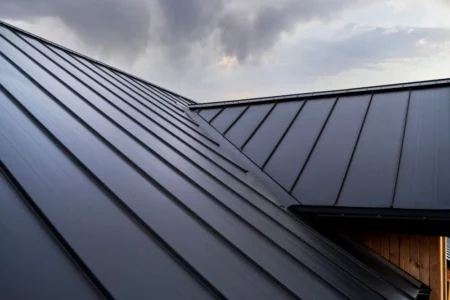 A roof made of metal has one of the highest life expectancies when fitted properly. On average, composite shingles endure 25 years, asphalt shingles 20 years, and wood shakes as well as shingles 30 years. While zinc roofs were previously known to endure 80 years or more, steel and aluminum roofs may easily last more than fifty years.
A roof made of metal has one of the highest life expectancies when fitted properly. On average, composite shingles endure 25 years, asphalt shingles 20 years, and wood shakes as well as shingles 30 years. While zinc roofs were previously known to endure 80 years or more, steel and aluminum roofs may easily last more than fifty years.
If a metal roof is installed correctly, the homeowner should not have to worry about it for the time they own their home. This is why they’re called lifetime roofing systems. A metal roof damage repair done well might last just as many years as the entire roofing system itself. If such repairs are done incorrectly, they might swiftly fail and break, leaving the property owner or facility owner with a persistent leak.
Because of incorrectly fitted screws or holes created by damaged roof elements, metal roofs frequently leak. The internal damage and mold development that a persistent leak might bring about is more significant. It’s essential to fix a roofing issue as soon as possible and appropriately. Fortunately, homeowners can patch, seal, and clean a hole beneath their metal roof themselves.
How Much Does a Metal Roof Repair Cost?
The cost of repairing a metal roof will fluctuate depending on the severity of damage done and your ability to handle the work yourself. Some repairs cost between $1 & $5 per foot of space and are dependent on the size of the area. These often involve patching up or replacing fasteners, re-coating roofing panels, or installing new panels. They also frequently include sealing leaky seams.
Small leaks, rust, and cracks can be fixed by homeowners directly to save on costs related to labor. Larger fractures, buckling, or wrinkling, however, may necessitate replacement. For the long-term viability of your roof in these situations, it is advisable to consult someone with expertise to guarantee that a metal roof repair is made appropriately.
Most leaks may be found in your attic by looking for rafters and joists that have water damage, but if you’re having trouble, an expert can also assist you in identifying the leak’s origin.
Special Factors to Consider With Metal Roofs
Metal roof repairs can be extremely challenging. Because the patched region may experience differing rates of contraction and expansion than the surrounding metal, metal roofing repairs are vulnerable to early failure. Stress on the repair can result in cracking, dividing, and ultimately failure within the patch because of the differential in contraction and expansion between the two materials.
Make the repair area clean
Cleaning the surface is the first step in repairing any metal roofing material. Click here to read more on the material that metal roof panels are made of. Any variety of things, such as a huge branch falling across the roof surface, might result in an opening in a metal roofing system, including degradation and rust. Whatever the reason for the hole, the region around it is probably unclean and needs to be cleaned.
Use Simple Green or a similar cleaning agent to scrub the metal panel’s surface well until it is clear of any debris, film, and/or algae development. When the cleaning operation is over, make sure to wipe away any cleaner residue with a moist cloth since it will jeopardize the sturdiness of the roof repair.
Patches are cut after measuring the repair area
Cut those selected sheet metal to the appropriate size for the mended area. At least two inches beyond the boundaries of the damaged area, the sheet metal repair should extend onto the metal panel. To avoid any sharp edges acting as a catch point for snow or ice, round the patch’s corners using a file and emery cloth once it has been carefully cut and fitted to size.
Place the Repair Patch in place
Staying exactly inside the specified pencil line, apply a color-matched polyurethane sealer to the surface of the metal panel that needs repair. To ensure there are no holes or gaps at the outermost portion of the patch, liberally apply sealant to the area.
Over the injured area, press the bandage into place. Along the edges of the patch, the sealant ought to squeeze out. If there are any spots where the sealant isn’t seeping, this means that moisture may eventually seep under the patch and deteriorate it. Here, use a bit of extra sealant to close up any gaps.
Protect the Patch
To match the roof, paint the patch. If desired, the patch’s surface can be painted to correspond with the metal roof panels’ color. To do this, softly wire-brush the metal patch’s surface as well as the metal panel’s surface that extends over the patch’s margins.
Paint the panel underneath the patch as well as the patch’s surface. Before the surface receives paint, the sealer may need to be fully cured. Additionally, make sure the paint and the sealer you used are compatible.
Picture Credit: Freepik
